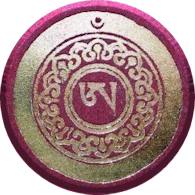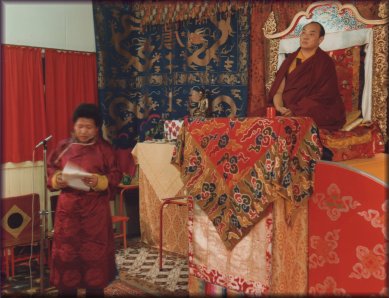
The Special Connection
with the XVIth Gyalwang Karmapa: 2
The Secret Yogi and a Special Emanation
Although it was never formally stated on paper [1], Katia and I came to understand that Akong Rinpoché was one of the XVIth Karmapa’s current emanations in the world. This became clear to us through Rinpoché’s own disclosure, through what the Karmapa made clear to me and through what a few of the visiting rinpochés confirmed. In this respect, the XVIth Gyalwang had at one time laughed loudly, in his inimitable and beautiful way, when asked whether he had other emanations in our world and said yes, many of them, at least nine there in India [2]. These other emanations of the Karmapa enable a vast range of activities to take place, beyond the scope naturally limited by the flagship role of being monastic head of the Karma Kamtsang tradition. Akong Rinpoché was undoubtedly one of these.
 Visiting teachers, such as Khenchen Thrangu Rinpoché and Khenpo Tsultim Gyamtso Rinpoché, not to mention Rinpoché himself, often described Akong Rinpoché as a “secret yogi”, [3] meaning not an obvious yogi wearing the cotton cloth or yogi robe and living in cave with long hair etc. but rather one who has the appearance of a worldly person yet behind the
scenes is making much dharma happen... and profound dharma at that. The very nature of the “ordinary” appearance enables something powerful to happen. Were the secret services of nations not so much in poor repute these days, one could describe the sbas pa’i rnal ‘byor as the “secret agents” of dharma. To understand this point is far from easy in the case of someone like Akong Rinpoché. On one hand he was a prominent public figure and became more and more so as he advanced in years. He was not—as some
secret yogis are—totally “under cover” by any means. Yet on another hand his secret yogi activity was constant and significant.
Visiting teachers, such as Khenchen Thrangu Rinpoché and Khenpo Tsultim Gyamtso Rinpoché, not to mention Rinpoché himself, often described Akong Rinpoché as a “secret yogi”, [3] meaning not an obvious yogi wearing the cotton cloth or yogi robe and living in cave with long hair etc. but rather one who has the appearance of a worldly person yet behind the
scenes is making much dharma happen... and profound dharma at that. The very nature of the “ordinary” appearance enables something powerful to happen. Were the secret services of nations not so much in poor repute these days, one could describe the sbas pa’i rnal ‘byor as the “secret agents” of dharma. To understand this point is far from easy in the case of someone like Akong Rinpoché. On one hand he was a prominent public figure and became more and more so as he advanced in years. He was not—as some
secret yogis are—totally “under cover” by any means. Yet on another hand his secret yogi activity was constant and significant.
There are two aspects to consider that may be helpful at this point, namely the nature of his secret activity to help dharma and beings and also the personal accomplishment and divine inspiration aspects behind what secret yogis do:
1. THE NATURE OF THE ACTIVITY:
Behind the obvious and manifold activities of Akong Rinpoché, as described in this text and as may be described in any outer official biography, was a powerful inner and secret force enabling the dharma to implant itself, in Scotland and elsewhere, overcoming powerful local (national) energies of resistance to dharma by skilful means of the four activities [4], protecting the Kagyu lineage and especially so in respect of the Karmapa
succession and protecting disciples in their dharma practice.
All this took place on a subtle level of reality and did so behind an appearance of great ordinariness. Akong Rinpoché was well-known as being very approachable and as someone never inclined to airs and graces. Realising that people often use notions of spirituality and religion to enhance their fantasies rather than reduce them, he played down any ides of his own spiritual power and spiritual influence, often saying things like,
“People ask me what my vision of things is—my vision of the future—but I have no visions. I tell them this again and again but they do not believe me,”
or
”I have no miracles.”
However, he did “have miracles” and these were witnessed personally by the author and have been recounted to the
author as personal experiences by others. Most particularly, although he may not have had clear and detailed visions of the future, he certainly had his finger on the pulse of the present and sensed what needed to be done. On several occasions, at his request, I had to contact his disciples in other countries or continents in order to warn them of a danger coming that they did not anticipate but that he suddenly sensed. This literally saved the lives of people. Sometimes this happened when there had been no contact
for weeks or months. Rinpoché’s own power of samaya and his compassionate connection with his disciples made these things happen spontaneously.
2. THE PERSONAL ACCOMPLISHMENT AND DIVINE INSPIRATION:
This second aspect is connected with the above. Through Akong Rinpoché’s own pure samaya with the Kagyu lineage and the other lineages he held, he literally became a tool in the hands of the pure dharma forces at work in this universe: forces such as Guru Rinpoché or the Healing Buddha. One can view this in a "bottom-up" or "top-down" way.
To illustrate the first, one retreater once asked Lama Yeshe Losal,
“Sometimes Rinpoché seems just like an ordinary person, talking or working with you in a very regular way, and then at other moments, such as during empowerments, he seems like Buddha himself. How does that work?”
Lama Yeshe’s reply was,
“Yes, it’s like he has a switch and can turn it on whenever he wants and then turn it off again.”
This bottom-up approach sees his ability to “become buddha” as his own yogic accomplishment.
The top-down view is not totally different but puts us in a perspective of the macro forces at work—for good or evil—in this world and shows how a pure being, such as Rinpoché, can be used, swept up by a current of enlightened energy, in order to perform the necessary activities of the great buddhas and bodhisattvas. One small illustration of this was the Guru Rinpoché activity to combat the harmful physical and spiritual effects of smoking, as expressed in several previously-concealed texts. The author’s belief, through observation, is that Akong Rinpoché played a key role behind the scenes in raising world awareness of the harm of tobacco, as well as doing so more obviously in his dharma teachings and personal advice to smokers. Rinpoché possessed one of these terma texts [5] about smoking—a rare and old piece of dark blue silk, on which the words were hand-written by Guru Rinpoché’s consort, Yeshe Tsogyal. He showed this to the author in the early-1970s, along with a translation that he had had made. It explained how, in this age when cities are illuminated at night-time and palls of smoke and pollution lay over them, Avalokitesvara and Manjushri would jointly emanate their power to eliminate smoking. The author’s belief is that this particular energy animated Akong Rinpoché and worked through him and in the world to raise awareness of and concern for the harmful effects of tobacco. One localised effect of this was that many people who had been previously unable to quit smoking, including the author, managed to do so “through his blessing”.
[1] One of the reasons for mentioning here.
[2] These emanations of various sorts, known as birth incarnations and various incarnations are one of the qualities of high-level bodhisattvas. This statement should not be confused with the erroneous argument for “two Karmapas” evoked by Thaye Dorje followers in recent years. The main Kagyu scholars have made it clear that there is only one Karmapa in the sense of an incarnation heading the Kamtsang tradition.
[3] sbas pa’i rnal ‘byor
[4] The four modes of conduct of the yogi: pacifying, increasing, empowering and subduing.
[5] I believe he later offered this rare text to a lama of the Nyingma tradition but I am unsure. The translation of this particular text was loaned to someone by Rinpoché and never returned. I have seen several tobacco-termas online, such as those held by Dudjom Rinpoché, but none as comprehensive and striking as the one he showed me.
......continue to the next part of the story: Rinpochés role in the 1974 visit of the Gyalwang Karmapa
